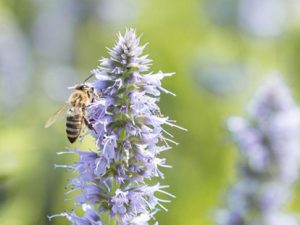Managing habitat for flowering plants may mitigate climate effects on bee health
By Chuck Gill

Monitoring honey bee colony weight with automated hive scales can be a proxy for the availability of flowering plants, helping researchers’ study how land cover, climate and weather conditions interact to affect bee health. Credit: Courtesy Natalie Boyle, Penn State. All Rights Reserved.
UNIVERSITY PARK, Pa. — Warm, wet weather conditions and changing climate negatively influence the nectar intake and nutritional health of honey bees, but maintaining large tracts of grassy natural habitat with flowering plants around apiaries may help to mitigate the detrimental effects of climate, according to a new study by an international team of researchers.
The pollination provided by bees and other insects is critical for crop production and ecosystem health, but some wild and managed pollinator populations have declined significantly around the world, the researchers noted. A major driver of these declines is loss of habitat and flowering plants — the food sources for pollinators — likely due to climate change and shifts in land use.
“However, the effects of land cover can be specific to a particular location,” said lead author Gabriela Quinlan, postdoctoral scholar in entomology in Penn State’s College of Agricultural Sciences.
“Previous research looking at the influence of land cover, weather and climate on bee health found a greater impact from weather and climate,” she said. “But no studies have monitored colonies over sufficient time and space to determine how climate and weather interact with landscape quality to affect honey bees’ ability to gather nectar in North America.”
A variety of factors affect the availability of flowering plants across locations and time periods, Quinlan explained, so researchers needed a standard, low-effort method for surveying honey bee colonies’ intake of food resources. They found that the use of automated hive scales can provide colony-level measurements of hive performance by monitoring changes in honey bee colony weight within and across days and seasons.
“Honey bee colonies must collect and store foraged pollen and nectar to support a large population and continuous brood-rearing over the growing season,” she said. “So, changes in colony weight are closely tied to changes in food availability over time. This colony weight data may be a proxy for estimating landscape-level flowering resources.”
To estimate the relative importance of climate, weather and land cover on flowering plant resources, the researchers combined hive scale data from several honey bee studies spanning five years, 162 apiary locations and 644 colonies in seven states — Michigan, Minnesota, North Dakota, Ohio, Pennsylvania, South Dakota and Wisconsin. They focused on the period of late summer nectar flow in July and August, a critical time when colonies must collect sufficient resources to survive the winter.
To read the entire article go to:
We are here to share current happenings in the bee industry. Bee Culture gathers and shares articles published by outside sources. For more information about this specific article, please visit the original publish source: Managing habitat for flowering plants may mitigate climate effects on bee health | Penn State University (psu.edu)








